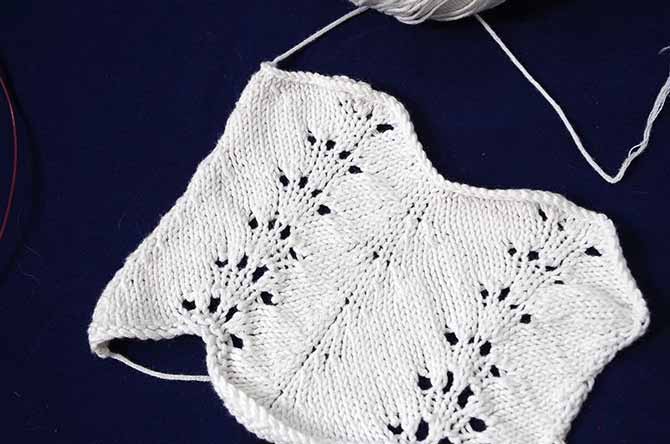Ripple lace stitch patterns are a favorite for summer knits. Try out the new Cotton True Sport by Fibra Natura and try your hand at a custom ripple lace stitch pattern.

2 different ripple lace patterns in Cotton True
In the above photo you can see some asymmetrical lace patterns that make an interesting swirl and wave in the fabric. There are 2 different patterns, one below and one above the garter stitch line. Both make the waves a bit irregular.
Or do you like symmetry more? You can always try something like this…

Symmetrical Ripple Lace stitch pattern
The most important part of making up your own ripple stitch patterns is to always make the number of increases equal the number of decreases. You can arrange either the increases or the decreases regularly in symmetrical order, or you can freeform it a bit as well. For summer ripple lace, eyelets made with yarn-overs are the most common way to increase. In case you missed yesterday’s post, we explored the possibilities for increases there — the different decreases were covered on Tuesday.

Hand-drawn knitted ripple lace charts
I often chart my own ripple lace patterns on simple math graph paper, no fancy software, no expensive gel pens and parchment paper, either. At this stage I don’t worry about gauge or the fact that there are more rows than stitches to an equal distance, say 4″ [10m]. The gauge will only become important when the stitch pattern is used in a garment.
If you look at the lower edge of the above photo, you can see that I have 40 stitches divided into 4 sections of 10 stitches each. At the outer edges and the center half-way point, I work paired decreases, and closer to the ¼ and ¾ marks, I work a series of increases, some paired symmetrically, and some not. This is where you can play around and see what you like best. You don’t have to work with 40 stitches. A ripple pattern repeat can be built out of any equal number of stitches between the peak points and the valleys.
The next thing to remember is that wrong side rows aren’t shown. Typically you simply purl across. If you do have a double wrapped yarn-over, there are several options we looked at yesterday for working into these double yarn-overs on the wrong side rows. So on the chart, we only draw symbols for right-side rows. I use circles for yarn overs, and right or left leaning lines to correspond to the leaning decreases.
Again, the key to balanced ripple lace stitches in your knitting is to add the same amount of increases to the increase sections as you add decreases in the decrease section. If you look at the first three rows of my hand-drawn diagram, you can see that I add six yo stitches to each section. Then, at either end of a pattern repeat, you can see that I also decrease 3 on one side and 3 on the other. These increases and decreases are done all on the same rows.
It is possible however to work the increases and decreases on different rows.

Multiple increases on 1 row are balanced by decreases made in subsequent rows
In the above swatch, you can see 5 eyelets in a row. These are all filled with 2 stitches each. So for this row there’s a massive multiple increase of 10 stitches per pattern repeat…and NO decreases.
To return the stitch count to the proper number, on the following 3 right-side rows, I decrease 3 stitches per pattern repeat with a single k2tog on the left side and a sssk (3 sts together through back loop) on the right side. Over these 3 rows, that took care of 9 of the extra 10 stitches that were added in the increase row. So that left 1 more stitch to decrease which was inserted at the edge of the pattern repeat on the next row. If you want to try this ripple stitch, the chart is included below.
Try making a few ripple lace stitch patterns of your own. It’s addicting!

Chart notes: Ripple Lace Chart

Two repeats (60 stitches) of this pattern would make a lovely scarf in sport weight yarn.
Row 1: [K7, yo, k6, k2tog, ssk, k6, yo, k7] twice (60 sts).
Row 3: [K8, yo, k5, k2tog, ssk, k5, yo, k8] twice (60 sts).
Row 5: [K9, yo, k4, k2tog, ssk, k4, yo, k9] twice (60 sts).
Row 7: [K10, yo, k3, k2tog, ssk, k3, yo, k10] twice (60 sts).
Row 9: ([K8, {yo twice, k1} 5 times, k5] twice, k2) twice (100 sts).
Row 11: [Ssk, k20, k3tog, sssk, k20, k2tog] twice (88 sts).
Row 13: [Ssk, k17, k3tog, sssk, k17, k2tog] twice (76 sts).
Row 15: [Ssk, k14, k3tog, sssk, k14, k2tog] twice (64 sts).
Row 17: [Ssk, k28, k2tog] twice (60 sts).
Row 19: [Ssk, k6, yo, k14, yo, k6, k2tog] twice (60 sts).
Row 21: [Ssk, k5, yo, k16, yo, k5, k2tog] twice (60 sts).
Row 23: [Ssk, k4, yo, k18, yo, k4, k2tog] twice (60 sts).
Row 25: [Ssk, k3, yo, k20, yo, k3, k2tog] twice (60 sts).
Row 27: [K2, {k1, yo twice} 5 times, k16, {yo twice, k1} 5 times, k2] twice (100 sts).
Row 29: [K18, k2tog, k2, sssk, k3tog, k2, ssk, k18] twice (88 sts).
Row 31: [K15, k2tog, k2, sssk, k3tog, k2, ssk, k15] twice (76 sts).
Row 33: [K12, k2tog, k2, sssk, k3tog, k2, ssk, k12] twice (64 sts).
Row 35: [K11, k2tog, k6, ssk, k11] twice (60 sts).
Repeat rows 1-36 for pattern.
